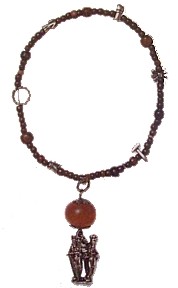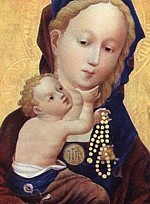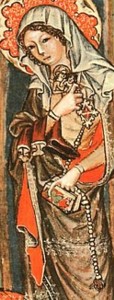|

clothes
&
accessories
dress
accessories
jewellery
brooches
rings
necklaces
paternosters
& rosaries
reliquaries
|

Paternosters
& Rosaries
WHAT IS A PATERNOSTER
- STRINGING MATERIALS - BEAD MATERIALS
THE PATER NOSTER - THE AVE MARIA
 Paternosters
were popular before, during and into the late the middle ages.
From as early as 1000AD, paternosters or prayer beads have been
a common dress accessory. Paternosters
were popular before, during and into the late the middle ages.
From as early as 1000AD, paternosters or prayer beads have been
a common dress accessory.

What
is a paternoster?
Cistercians in the 11th and 12th centuries allowed lay brothers
and sisters to recite the Pater Noster, the Our Father
instead of 150 psalms and lessons. Originally, the beads helped
with counting and were not a fashion accessory.
Shown at right is a paternoster
with wooden beads and silver gauds with a large amber bead at
the bottom and a gilt pendant terminus.  It
dates from the 15th century and is of German origin. Instead of
having a large bead or marker to break the number of beads, the
gauds are each different and represent each of the instruments
of the passion of Christ. It
dates from the 15th century and is of German origin. Instead of
having a large bead or marker to break the number of beads, the
gauds are each different and represent each of the instruments
of the passion of Christ.
At left is a close up of
another pendant terminus, this one gold, and of St Christopher.
It is also German and from the 15th century.
Paternosters were usually made long and in a loop for women and
short and straight for men usually in a string of 10, 50 or 150
beads either with or without dividers.
 The
detail from painting at right is from the mid 1400s work Mother
of God With Pea Blossom from the Master of Cologne, Germany.
It shows Mary with a gold paternoster. The
detail from painting at right is from the mid 1400s work Mother
of God With Pea Blossom from the Master of Cologne, Germany.
It shows Mary with a gold paternoster.

Stringing
materials
Paternosters and rosaries provided a unique opportunity for a
woman in particular to appear pious while at the same time taking
the opportunity to display a show of wealth in the materials and
fixing of her beads. A woman's paternoster could be a string of
knots on a cord or a string of beads.
Known stringing materials included green silk, tubular silk braid,
silver and gold wire.

 Bead
materials Bead
materials
The most popular bead materials were red coral, amber, bone, boxwood
and crystal.
Known bead materials include agate, amber, amethyst, chalcedony,
clay, coral, carnelian, crystal, diamonds, emeralds, enameled
gold, garnet, gilt, glass, gold, horn, ivory, jasper, jet, mother
of pearl, onyx, pearls, paste, rock crystal, rubies, sapphires,
shell, silver, turquoise, apricot kernels, bone and a variety
of woods- ebony, mazerwood, mistletoe, yew and boxwood.
 Coral
was particularly popular, as coral was thought to ward against
the evil eye. Coral
was particularly popular, as coral was thought to ward against
the evil eye.
The Our Father beads or gauds dividing groups of ten beads
were often larger than the others on the strand.
The beads in the paternoster
shown at left are dated from 1250 and are of Anglo Norman make.
They were uncovered in the Waterford City excavations in
England and are made of amber.
Since this jewellery was
for the greater glory of God and not for personal adornment, the
church was unwilling to place a ban on the owning or wearing of
excessively rich and ornate paternosters.
Paternosters were often exempt from taxes restricting rich clothing
and ornamentation, so wearing an expensive string of beads as
a paternoster provided an opportunity for showing off wealth and
good taste, as well as one's devotion to the Almighty. Even a
woman who was not particularly pious often did not pass up such
an opportunity to display jewellery.
At right is a worn effigy
from 1369. It is one of the weepers from the tomb of Thomas Beauchamp
and his wife, Katherine Mortimer at St Mary's church at
Warwick, England. It is hard to define whether the beads were
in her hand which was originally resting on her hip or whether
the beads were attached to her belt- a common practice with paternosters.
 Among
the early mentions of prayer beads in England is the will of Lady
Godiva who died in the 11th century. When she died, she left Among
the early mentions of prayer beads in England is the will of Lady
Godiva who died in the 11th century. When she died, she left
a circlet of gems that
she had threaded on a string, in order that by fingering them
one by one as she recited her prayers, she might not fall short
of the exact number
to a monastery which she
and her husband had founded.
The 1350 illumination detail, shown below at right, is of Saint
Hedwig of Silesia from the Hedwigs Codex shows Saint Hedwig
with a linear rosary, which is unusual for a woman.
The string of beads is unlooped and long, rather than the usual
woman's looped form or the usual linear and short style. At the
end is a tassel, and the paternoster is shown hanging down from
what appears to be a brooch at the edge of her cloak or on her
gown.
The brooch itself is a diamond
shape decorated version of the common ring brooch which was widely
used on cloaks and outer garments throughout the medieval period.

The
Pater Noster or Lord's Prayer
Below is the Lord's Prayer, the Pater Noster, and
the Hail Mary, Ave Maria in latin as it would have been
said during the medieval period for prayers and the old English
translation at the time of 14th century England.
It is particularly interesting to note that in the Lord's Prayer,
the supplicant prays to be forgiven for their debts and
to forgive those that debt against us, rather than their
tresspasses, which was changed as the prayer books were
standardised.
Pater
Noster
Pater noster qui es in coelis
Sanctificetur nomen tuum
Adveniat regnum tuum
Fiat voluntas tua
et in terra sicut in coelo
Panem nostrum quotidianum
da nobis hodie
Et dimitte nobis debita nostra
sicut et dimittemus debitoribus nostris
Et ne nos inducas in tentationem
sed libera nos a malo
Amen
The Lord's Prayer
Fader oure that art in heven
halwed be thi name;
come thi kyngdom
fulfild by thi wil
in heven as in erthe;
oure ech-day bred
yef us to day,
and foryeve us oure dettes
as we foryeveth to our detoures;
and ne led us nought in temptacion,
bote delivere us of evel.
So be it.

The
Ave Maria, or Hail Mary.
The litany of the
Ave Maria remains one of the standard confessional sentances to
this day.
Ave Maria
Ave Maria, gratia plena
Dominus tecum
Benedicta tu in mulieribus
Et benedictus fructus ventris tui.
Amen
Hail Mary
Hail Marye, ful of grace
God is with the
of alle wymmen thou art most blessid
and blessid be the fruyt of thi wombe, Ihusus.
So mote it be.

Copyright
© Rosalie Gilbert
All text & photographs within this site are the property of
Rosalie Gilbert unless stated.
Art & artifact images remain the property of the owner.
Images and text may not be copied and used without permission.
|